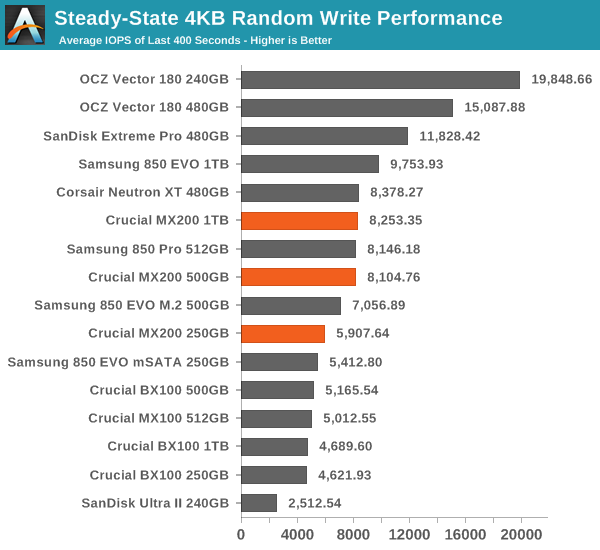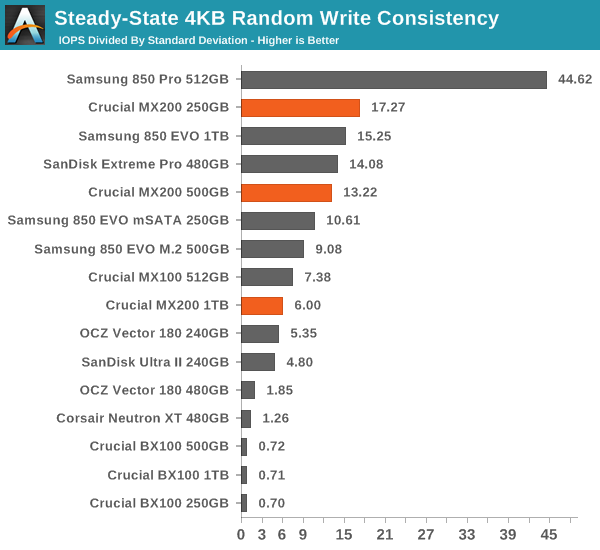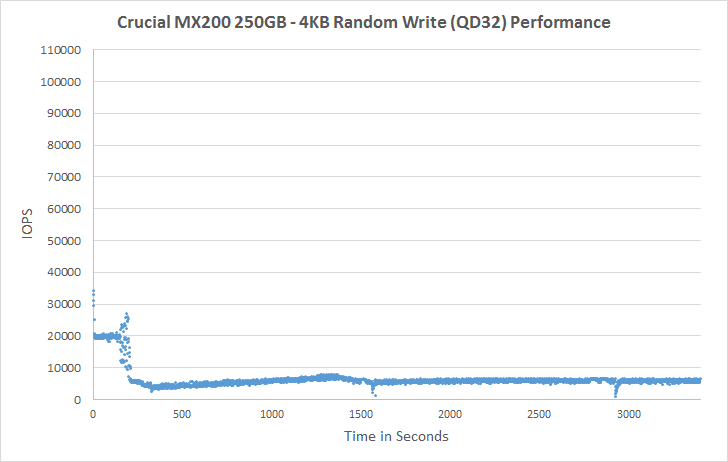Crucial MX200 (250GB, 500GB & 1TB) SSD Review
by Kristian Vättö on May 22, 2015 8:00 AM EST- Posted in
- Storage
- SSDs
- Crucial
- MX200
- Micron 16nm
Performance Consistency
We've been looking at performance consistency since the Intel SSD DC S3700 review in late 2012 and it has become one of the cornerstones of our SSD reviews. Back in the days many SSD vendors were only focusing on high peak performance, which unfortunately came at the cost of sustained performance. In other words, the drives would push high IOPS in certain synthetic scenarios to provide nice marketing numbers, but as soon as you pushed the drive for more than a few minutes you could easily run into hiccups caused by poor performance consistency.
Once we started exploring IO consistency, nearly all SSD manufacturers made a move to improve consistency and for the 2015 suite, I haven't made any significant changes to the methodology we use to test IO consistency. The biggest change is the move from VDBench to Iometer 1.1.0 as the benchmarking software and I've also extended the test from 2000 seconds to a full hour to ensure that all drives hit steady-state during the test.
For better readability, I now provide bar graphs with the first one being an average IOPS of the last 400 seconds and the second graph displaying the IOPS divided by standard deviation during the same period. Average IOPS provides a quick look into overall performance, but it can easily hide bad consistency, so looking at standard deviation is necessary for a complete look into consistency.
I'm still providing the same scatter graphs too, of course. However, I decided to dump the logarithmic graphs and go linear-only since logarithmic graphs aren't as accurate and can be hard to interpret for those who aren't familiar with them. I provide two graphs: one that includes the whole duration of the test and another that focuses on the last 400 seconds of the test to get a better scope into steady-state performance.

It looks like Crucial has finally taken steps to improve steady-state performance, although the additional over-provisioning is partially to thank for the increase. One criticism I always had about Crucial's SSDs was the relatively bad steady-state performance, but the MX200 finally brings the performance closer to other high-end drives.

The consistency is very good as well and far better than what the BX100 offers.
 |
|||||||||
The IO consistency appears to behave differently from the MX100 and the graph resembles 850 EVO and Pro quite a bit by dropping quickly in performance and then slowly increasing before evening out. The 1TB model is an exception, though, as it seems that the firmware can't properly handle such a large capacity, which results in worse performance and considerably higher variation. Unfortunately, the MX200 wouldn't respond to the hdparm command that I use for over-provisioning testing, so I don't have any results with added over-provisioning at this point.
 |
|||||||||










62 Comments
View All Comments
busky2k - Friday, May 22, 2015 - link
Thanks for the honest review. Its a shame the MX200 doesn't excel like its brethren.romrunning - Friday, May 22, 2015 - link
Agreed. That's why I appreciate seeing independent tests of manufacturers' claims. Crucial/Micron just showed me why I'll still buy Samsung over their drives. It's a shame; I used to recommend the MX100 as the best value drive. Now it's the 850 EVO all the way for value drives.sabot00 - Friday, May 22, 2015 - link
I feel the BX100 at the very least deserves consideration. The 850 Evo is not a blanket recommendation, especially for laptops where power consumption is important. The BX100 is probably the best mix of price / performance / power right now.Stoatie - Friday, February 12, 2016 - link
Then what you really want to look at is energy use for a given IO task. Consider the 512GB EVO and BX:EVO: ~350MB/s @ 1.6W. = 218.75 MB/J =
BX100: 300MB/s @ 1.4W = 200 MB/J
For a given task the EVO will finish faster and do it with less total energy use.
leexgx - Tuesday, May 24, 2016 - link
but overall BX100 uses less power (i norm aim to buy BX100 for laptops unless SED drive is required then its norm intel 1000 or 2000 drive)Samus - Friday, May 22, 2015 - link
Considering the price of the M500's (960GB model <$300) I still use those almost exclusively unless the MX\BX100's happen to be cheaper. Been very happy with Crucial drives since the C300, very few issues and decent performance for the price. Support is now excellent with their "storage executive" software making firmware updates relatively painless.emn13 - Friday, May 22, 2015 - link
Given the fact that most workloads won't cause noticable differences between high end and low end drives, the price, and the power loss protection mean that the ancient m500 is probably a better choice both featurewise and pricewise than its newer, faster competitors for most PCs.leexgx - Saturday, May 23, 2015 - link
Don't like the idea of DWA drives twice the amount of writes and silly more power draw (the bx100 is a good way on power just lacks FDE witch is unfortunate) mx200 is not on my list of drives to getedlee - Friday, May 22, 2015 - link
i am not sure why crucial stopped producing m550, it performs better than mx100 and mx200 series, and was true successor to the legendary m4 driveDanNeely - Friday, May 22, 2015 - link
Are the flash chips and controller it uses still available? If either has been discontinued they wouldn't have a choice. Even if the flash was available, but just significantly more expensive; keeping a competitive price would likely force their hand.